SAP Project Plan
Implementing the SAP system in a company is a strategic project that affects each and every employee, and the implications need to be understood and planned before taking on this endeavor.
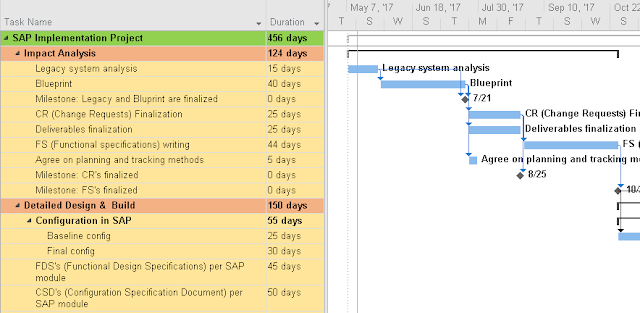
There are many different modules available in the SAP system, and since each company has different needs not all modules are used in each implementation. All the modules are customizable, but this requires writing code in SAP using the ABAP (Advanced Business Application Programming) language.
Now we will look at the different Implementation phases in SAP Project Plan.
1. Impact Analysis
This is the first phase of the implementation, and the majority of the tasks include understanding the inputs & outputs of the legacy system (analysis), and planning how the new SAP system will be implemented (Blueprint).
The plan includes software and hardware needs. It is wise to invest time in the plan, since it is cheaper to find mistakes here than when the implementation has begun.
The main milestones are –
- The analysis of the legacy system and the plan for implementing the SAP is ready.
- The Change Requests (CR) for the SAP system are finalized, and the ABAP programmers are clear on their tasks and timeline.
- All the Functional Specifications (FS) are written. An FS is written by the business lead of the module, and explains a specific task that the SAP system needs to perform. For example: the HR module needs to able to present an employee’s basic info once their employee ID number is entered.
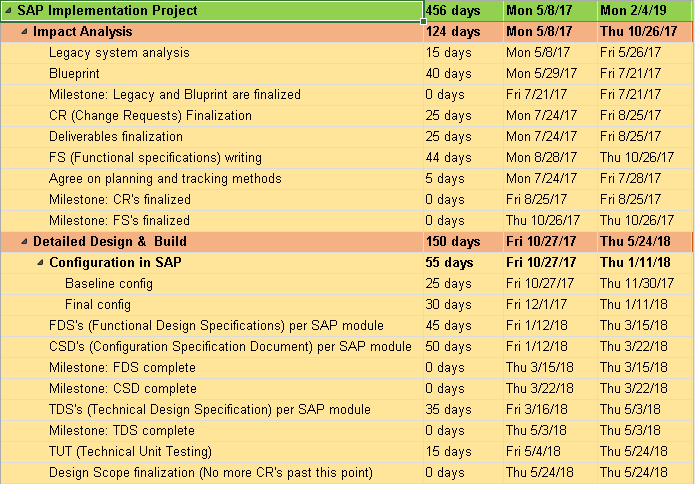
2. Detailed Design and Build
This phase is mainly done by the implementer of SAP, and entails understanding the FS’s and dividing them into two categories –
- CSD (Configuration Specification Document): This document will be used if the FS is covered by the standard out-of-the-box SAP version. It simply states to which database the SAP system needs to configure to in order to present the requested output.
- FDS (Functional Design Specification): This document will be used if the FS isn’t covered by the standard out-of-the-box SAP version. It explains to the programmer what the expected output should be, which fields are necessary in the menu, the interface, what the user needs to input and what the data flow is. Once the FDS is done, it is passed on to the programming team for them to use to create the TDS (Technical Design Specification), which is the customization of the SAP system according to the FDS.
The main milestones are –
- CSD’s are completed
- FDS’s are completed
- TDS’s are completed
TUT’s (Technical Unit Testing) are completed: This means that after the TDS is done, the SAP implementer tests it in the testing environment to make sure that the TDS was done according to the FDS.
3. Testing
This is a very important phase, and is done mainly by the testing team, with the assistance of the module teams. T
he testing is done in different environments, when the first tests are in the testing environment and the last are in the development environment which simulates the actual production environment and is subject to QA regulations (each company has different ones). The main milestones are –
-
FUT (Functional Unit Testing) completion –
This is done mainly by the testing team, and the purpose is to make sure that the task outlined in the FS is functionally possible in the SAP system. Done in the testing environment.
-
IIT (Interface Integration Testing) completion –
This is similar to the FUT, and the purpose it to make sure that the legacy interfaces work in the SAP system. Done in the testing environment.
-
E2E DR (End-to-End Dry Run) completion –
In this step a string of FUT’s are tested, which simulates a business process. Done in the testing environment.
-
FTT (Functional Technical Testing) completion –
Same step as the FUT, but done in the QA environment, which is subject to the regulations of the company.
-
E2E completion –
Same step as the E2E DR, but done in the QA environment, which is subject to the regulations of the company.
-
UAT (User Acceptance Testing) completion –
This step is done by the users and is assisted by the testing team. The business leads decides which processes they want to test from the E2E scope, and the users go through the steps. It also serves as a sanity check for the interface. Done in the QA environment.
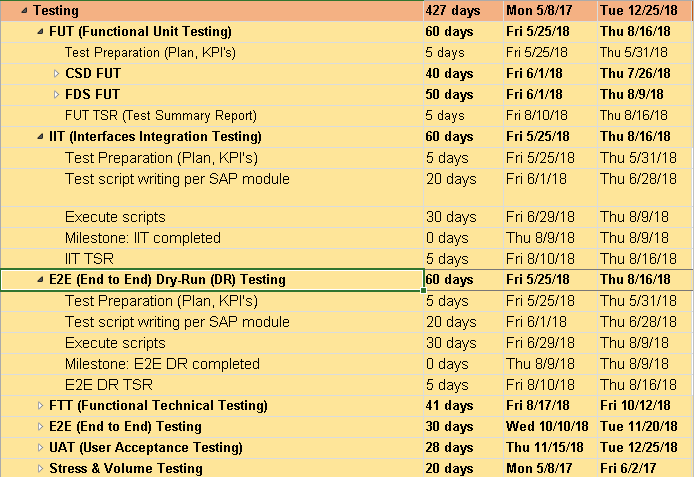
4. Data Migration
The goal of this phase is to Extract the information from the legacy system, Transform it to the SAP language, and Load it into the SAP. After the load is done, the team verifies that the information is accessible in the SAP system. The main milestones are –
-
Trial Loads completion –
The number of loads are determined by the implementer and the customer, according to the scope of information and the complexity of the project. Each load is ideally done automatically by the SAP system, but some manual loads are necessary. These loads should decrease in each load.
-
Production Load completion –
The last and most important trial load, where the legacy information is loaded into the production environment. This is the main predecessor of the Go-Live milestone.
5. OCM (Organizational Change Management)
Implementing a new system entails a big change, and the OCM team is in charge of leading the transformation. The main milestones are –
-
SOP (Standard Operating Procedure) completion –
re-writing the SOP’s of the legacy system, to be used as a how-to manual for the SAP users.
-
Role / Position Mapping –
Categorizing the users into groups, and deciding which permissions each group is assigned according to their role in the company.
-
Change Impact Analysis –
Determining who will be impacted by the new system, and how their role might change as a result.
-
Knowledge Transfer –
Passing the baton to the customers’ helpdesk, so they will be able to adequately support the users after the go-live.
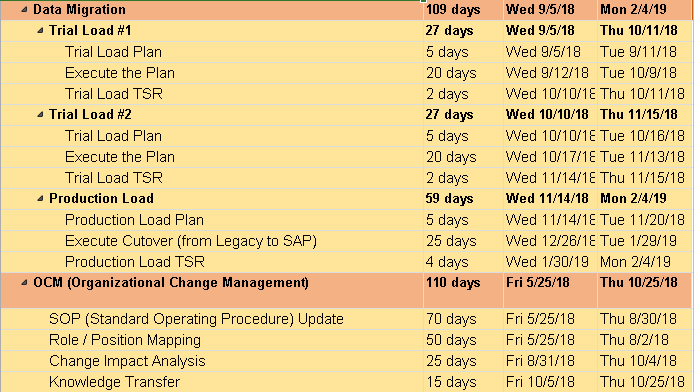
6. Infrastructure
This team is the only one who handles the hardware, and are in charge of the servers, printers (mainly for parcel stickers), guns for scanning the barcodes, etc. The main milestones include –
-
Aligning the hardware to the needs’ of the company -
Estimating the number of users and the required response time of the system. -
Upgrading the hardware –
Upgrading the hardware according to the estimation done in the first milestone (#6.a). -
Systems Build –
Cloning the legacy environment in the SAP hardware, and making sure that the new environment provides the same SLA (Service Level Agreement) as the legacy one.
7. Training
Teaching the users how to work with the new system. The main milestones are –
-
Writing the training manuals –
Which are used by the trainers, who are usually employees of the company or a third party vendor. -
TTT (Train the Trainer) –
Training the trainers from the previous milestone (#7.a), according to the manuals. -
EUT (End User Training) –
One of the predecessors of the Go-Live milestone. A task done by the training team.
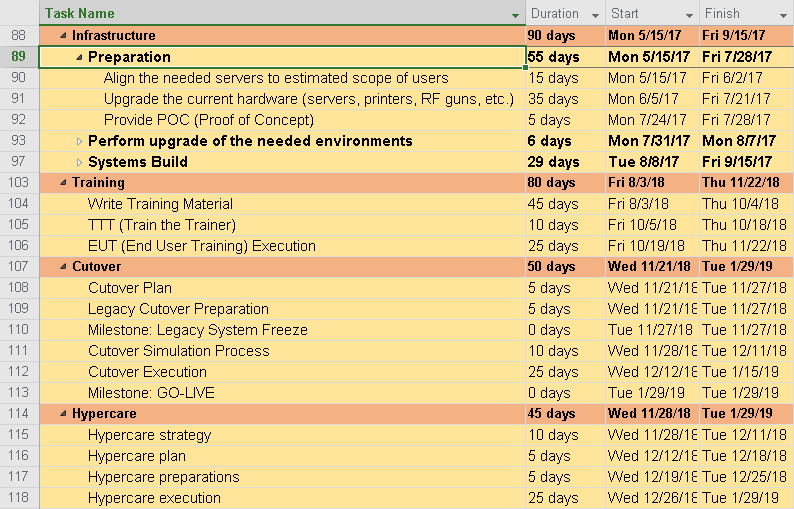
8. Cutover
The last phase of the implementation before the Go-Live, and is done by a dedicated team who assumes the responsibility for most of the tasks done in the period before the Go-Live. The main milestones are –
-
Cutover Plan –
Putting together a detailed day-by-day plan of all the tasks needed to Go-Live. -
Legacy System Freeze –
from this point all of the legacy systems aren’t used anymore and the company goes dark for a short period (usually less than a week). -
Cutover Execution –
All the info is taken from the legacy system, and transferred to the SAP. -
Go-Live –
Only the SAP system is used from this point on.




